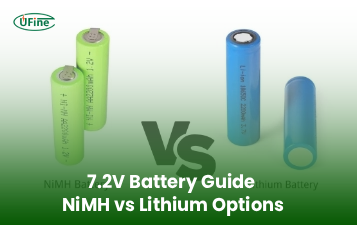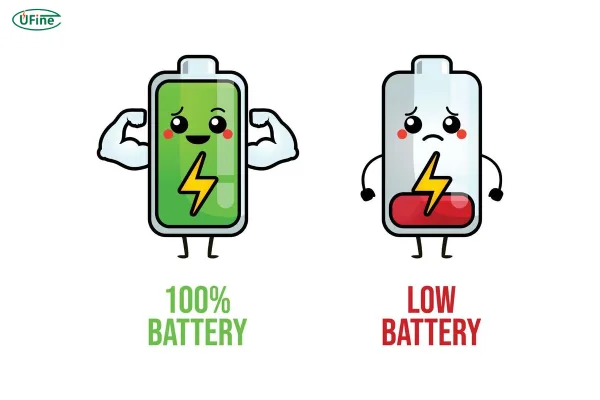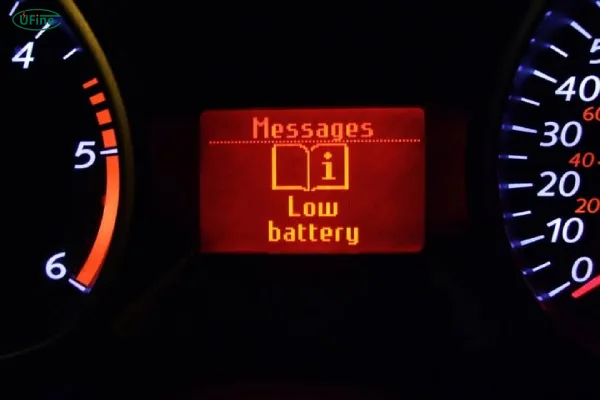
- Part 1. Why you should know the signs of a weak battery
- Part 2. What is a weak battery?
- Part 3. Slow engine crank
- Part 4. Dim headlights or interior lights
- Part 5. Electrical issues and malfunctions
- Part 6. Clicking sound when starting
- Part 7. Battery warning light on dashboard
- Part 8. Battery case swelling or corrosion
- Part 9. Needing frequent jump-starts
- Part 10. Age of the battery
- Part 11. Cold weather makes starting harder
- Part 12. Testing a weak battery with a multimeter
- Part 13. How to prevent your battery from getting weak
- Part 14. When to replace a weak battery
- Part 15. Conclusion: Don’t ignore weak battery symptoms
- Part 16. FAQs
A weak battery can turn a good day into a stressful one. Whether it’s your car, motorcycle, or any battery-powered device, battery failure always seems to happen at the worst time. But thankfully, batteries usually give warning signs before they die completely.
In this guide, we’ll explore what symptoms to watch for when your battery starts going bad. Recognizing these early can save you time, money, and headaches later.
Part 1. Why you should know the signs of a weak battery
Batteries are everywhere—cars, motorcycles, phones, UPS units, and more. But all batteries degrade over time. Knowing how to spot a weak battery helps you:
- Avoid being stranded
- Protect your electronics
- Prevent emergency repairs
- Save on battery replacement costs
Ignoring battery warning signs can lead to more serious issues, including complete electrical failure. That’s why early detection is key.
Part 2. What is a weak battery?
A weak battery is one that cannot hold or deliver sufficient power. It might not be dead, but it’s no longer performing like it should. It may crank slowly, lose charge quickly, or show voltage drops under load.
Common causes of battery weakness:
- Age (most batteries weaken after 3–5 years)
- Sulfation (build-up of lead sulfate in lead-acid batteries)
- Overcharging or deep discharging
- Vibration and heat damage
- Long periods of inactivity
The good news? Most of these issues can be detected early if you know the symptoms.
Part 3. Slow engine crank
One of the first and most noticeable symptoms of a weak battery is a slow engine crank.
You turn the key (or push start), and the engine turns over sluggishly. It might take a few extra seconds to start or make a whining sound.
This is a clear sign that your battery isn’t providing enough power to the starter motor, especially in cold weather.
Part 4. Dim headlights or interior lights
A weak battery often struggles to power accessories. Dimming headlights are a common symptom, especially when:
- You start the engine
- The car is idling
- You’re using multiple electronics (radio, AC, GPS)
If the lights get brighter when revving the engine, it’s likely due to a battery that’s not holding a charge well.
Part 5. Electrical issues and malfunctions
Modern vehicles are full of electronics—screens, sensors, ECUs. A weak battery can cause strange behavior such as:
- Radio cutting off
- Dashboard lights flickering
- GPS or infotainment system resetting
- Power windows moving slowly
- Alarm system acting erratically
All these are signs that the battery can’t maintain stable voltage under load.
Part 6. Clicking sound when starting
Hear a clicking noise instead of the engine starting? That’s another classic weak battery symptom.
This happens when the battery doesn’t have enough power to engage the starter solenoid. It tries to start, but fails to provide the necessary amps.
Sometimes, a jump-start will work. But if it happens more than once, your battery may be on its last legs.
Part 7. Battery warning light on dashboard
Most cars and motorcycles have a battery warning light. If it stays on while you’re driving, it usually means:
- The battery is weak
- The alternator isn’t charging properly
- There’s a charging system failure
Don’t ignore this light. Even if your vehicle starts fine, the battery may be failing and could stop working without notice.
Part 8. Battery case swelling or corrosion
Always check the physical condition of your battery. A healthy battery should have a clean, flat case and corrosion-free terminals.
Signs of trouble include:
| Physical Symptom | What It Means |
|---|---|
| Swollen battery case | Overheating or overcharging |
| Corrosion on terminals | Acid leakage or poor maintenance |
| Wet or leaking | Internal damage—dangerous |
| Burn marks | Potential short circuit |
Tip: If you notice any of these, replace the battery immediately. A swollen or leaking battery is dangerous and should not be recharged.
Part 9. Needing frequent jump-starts
If you need a jump-start more than once every few months, your battery is likely weak.
A healthy battery should hold a charge for days or weeks without problems. If yours dies after sitting for only a short time, it’s no longer reliable.
Part 10. Age of the battery
Battery lifespan varies by type, but most standard car batteries last 3–5 years. Even if your battery seems fine, it could be weakening inside.
| Battery Type | Average Lifespan |
|---|---|
| Car/Lead-acid | 3–5 years |
| AGM/Gel Cell | 4–6 years |
| Deep Cycle | 4–8 years |
| Lithium-ion | 5–10 years |
If your battery is more than 4 years old, start checking for signs of weakness—especially before winter.
Part 11. Cold weather makes starting harder
A weak battery often fails in cold weather. Batteries work best between 20°C–25°C (68°F–77°F). In freezing temps, their chemical reactions slow down.
If your car starts easily in summer but struggles in winter, your battery may be too weak for cold starts.
Part 12. Testing a weak battery with a multimeter
Want to check your battery at home? Use a digital multimeter.
Here’s how:
- Turn off your engine and accessories
- Set your multimeter to DC volts
- Connect the red lead to the + terminal and black to the – terminal
- Read the voltage
| Voltage Reading | Battery Condition |
|---|---|
| 🔋 12.6V or higher | Fully charged |
| ⚠️ 12.4–12.5V | Weak but usable |
| ⚠️ 12.2V or less | Weak – needs attention |
| ❌ 12.0V or below | Likely dead |
If your battery reads below 12.4V, it’s time to recharge, test further, or replace.
Part 13. How to prevent your battery from getting weak
You can’t prevent all battery issues, but regular maintenance helps extend its life.
🧰 Tips to maintain battery health:
- Drive your vehicle regularly
- Clean terminals with baking soda and water
- Avoid short trips that don’t charge the battery fully
- Use a battery tender when parked for long periods
- Don’t leave lights or accessories on while parked
Part 14. When to replace a weak battery
Sometimes recharging or maintenance isn’t enough. Here are signs your battery needs to be replaced:
- Swollen case or leaking acid
- Voltage drops quickly even after full charge
- Fails load test at auto shop
- Over 4–5 years old and showing symptoms
- Requires frequent jump-starts
Don’t wait for total failure. Replace a weak battery before it leaves you stranded.
Part 15. Conclusion: Don’t ignore weak battery symptoms
A weak battery rarely fails without warning. Slow cranking, dim lights, strange electrical problems—these are all signs that your battery is nearing the end of its life.
By catching these symptoms early, you can:
- Avoid being stranded
- Replace the battery on your terms
- Protect your vehicle’s electronics
- Save money and time
Check your battery regularly—especially before winter, long trips, or periods of inactivity. If you notice any of the warning signs we’ve discussed, it’s time to test, recharge, or replace your battery.
Part 16. FAQs
Can a weak battery affect car performance?
Yes. It can cause poor starting, ECU errors, and loss of power to systems like lights and sensors.
Can I still drive with a weak battery?
Sometimes, but it’s risky. If the alternator fails or more load is added, your vehicle could die mid-drive.
How do I know if it’s my battery or alternator?
Test voltage with the engine on and off. If it’s low when running, the alternator might be the issue.
Can idling recharge a weak battery?
Yes, but it’s slow and less effective than driving. Use a proper charger if possible.
Is it dangerous to use a weak battery?
It can be. A weak or swollen battery may leak acid or short-circuit, leading to serious damage or even fire.
Related Tags:
More Articles

NiMH vs Lithium 7.2V Battery and Charger: Which Is Better?
Compare 7.2V NiMH vs Lithium batteries and chargers in 2025. Learn runtime, weight, charging, lifespan, and cost to choose the best for your device.
How to Choose the Right 7.2V Battery and Charger for Your Device?
Learn how to choose the right 7.2V battery and charger for optimal performance, safety, and longevity across RC, tools, medical, and industrial devices.
Big Square Battery Safety Standards You Must Know
Learn key safety standards for big square batteries to avoid fire risks, shipping delays, and compliance issues in EV, industrial, and energy storage projects.
Big Square Battery Applications in Solar & Industrial Equipment
Big square batteries deliver high capacity, stable output, and long life for solar, industrial, and backup power. Explore key uses and advantages.
Big Square Battery vs Cylindrical Battery: Complete 2025 Guide for EVs, ESS & Industrial Devices
Choosing the right battery is key for designers and engineers. Compare big square vs cylindrical batteries to find the best fit for your application.




